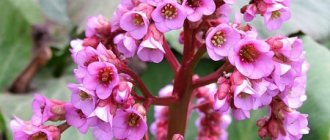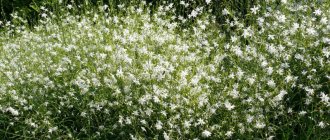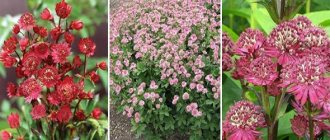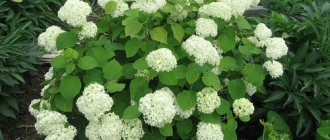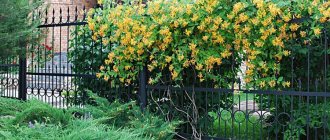Correct planting of mock orange
In open ground, mock orange should be planted according to certain rules.
- The place should be sunny;
- The plant should be planted in a hole measuring 0.5 x 0.5 m. The first layer should consist of pebbles or crushed stone. Then pour in a nutrient mixture consisting of part sand, 2 parts humus, 3 parts leaf soil;
- To get a hedge, mock orange must be planted close to each other;
- The root collar of the plant should be flush with the ground; if it is deepened too much, it may rot;
- Immediately after planting, pour a couple of buckets of water under the root of the plant;
- For normal planting, the distance between bushes should be 0.5-1.5 m.
Reproduction
This representative of the flora is bred using the following methods:
By layering
On a healthy bush, you need to trim the branches to “stumps” - 4-5 cm. Young shoots will appear on them later. It is necessary to wrap a tourniquet under the bud; until spring, a root system will form in this place. The shoot must be bent to the furrow and secured with staples.
Cuttings
Planting material is prepared in advance - in the fall. It is stored in a cool room, in a container with sand. Rooting is carried out in early April. The plant is placed in the hole at a slight angle; two buds should remain underground. In just 1-1.5 months they will take root. To create a bush, after a year the seedling is almost completely cut off, leaving only 3-4 cm.
Dividing the bush
This method is used when it is necessary to transplant jasmine. In autumn or early spring, the plant is watered abundantly and carefully removed from the soil. The roots must be washed off the ground, then the bush is divided into several parts. Before planting permanently, it is necessary to cut off the ends of the shoots and roots. The planting hole is filled with nutritious soil. Mock orange is watered abundantly.
Seeds
Seed germination is 1 year. They are sown in open ground even in winter. It is necessary to prepare ridges in the snow. After sowing is completed, the holes are covered with straw, leaves or spruce branches. It is better to plant in a greenhouse in spring or autumn. Pre-soak in warm water for better germination. After 3 hours, the seeds must be wrapped in damp peat or sawdust. As soon as they swell, they need to be dried, mixed with sand and planted. After 2 weeks, shoots appear. They are carefully dived.
How to water a plant and care for the soil
At the dacha, the bush must be watered periodically. In this case, watering should be plentiful. If there is not enough moisture, the leaves will begin to lose color and the flowers will become smaller. During hot periods, up to 30 liters must be applied per 1 m2. water.
Also in the garden it is necessary to regularly loosen the soil so that the mock orange feels good. Another important technique is timely removal of weeds. After loosening the soil, you can mulch it, this will protect the moisture from drying out. Peat can be used as mulch.
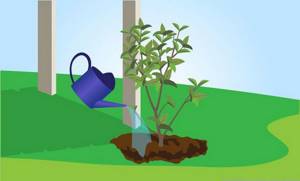
How to prune a bush correctly
For hygiene purposes, mock orange is pruned. It is produced in the spring, and the point is to remove dried and broken branches. Shoots that are not yet 12 years old are abandoned.
In the spring, thinning of the bush crown is also carried out. This provokes new shoot growth. Old bushes are simply cut down, and the cut areas are treated with garden varnish.
After pruning, all varieties of mock orange are fertilized with mullein solution. In autumn, the bushes produce many young branches. In the spring they will have to be removed, leaving only the strongest ones, which will form the backbone of the plant.

How to fertilize
All types of mock orange require periodic feeding. The addition of organic matter promotes lush flowering of the bush. In the first year of growth, garden jasmine is fed with slurry made from 10 liters of water and 1 liter of substance.
Growing mock orange from the age of two involves the application of mineral fertilizers. The first feeding is carried out in mid-May with a solution consisting of superphosphate, potassium sulfate, urea, and 10 liters of water. The presented mixture is consumed per 1 m2.
It is impossible to say for sure in what month the fertilizing is applied a second time. Wood ash and superphosphate are added after the bush has flowered.
Chubushnik
Many of us have more than once looked in the parks at the beautifully smelling shrub with delicate white flowers, which everyone calls jasmine. I, too, am fascinated by its beauty and dreamed of one day planting one in my garden: it’s beautiful, and you can add dried flowers to tea. Imagine my surprise when the nursery explained to me that the classic name of this shrub is mock orange, and some gardeners call it “garden jasmine”.
Content
“Two” words about jasmine
Jasmine belongs to the olive family. It is an erect or climbing shrub that blooms with delicately scented flowers in white, purple or yellow. The homeland of jasmine is Asia, the Arabian Peninsula, Transcaucasia. There are about two hundred species of jasmine in the world; in China alone, where it was brought two thousand years ago, there are about 90 species.

Classic Jasmine
Mock orange aka “garden jasmine”
Mock orange belongs to the hydrangea family. This is one of the most famous and popular shrubs. Mock orange blooms with delicate white flowers from late May until August.
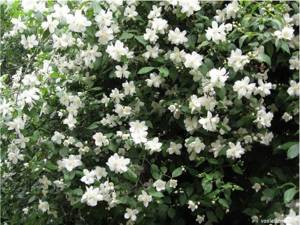
Mock orange blooms with beautiful white flowers
Mock orange is a sun-loving shrub with small leaves, thin stems with brownish or gray bark. Tolerates shade well. Its fruits are small capsules with seeds slightly less than one centimeter. Many species have perfectly adapted to live on waterlogged soils, but do not tolerate stagnant water well. They are able to withstand short-term drought without much damage and are not afraid of smoke (gas contamination). Not every type of mock orange has a rich, pleasant smell; some have a barely perceptible aroma, or even no aroma at all.
Landing
Mock orange tolerates shade well, but there its branches become very elongated and the flowers become smaller and smaller. If you offer the mock orange a sunny place, it will reveal its potential for you: it will bloom en masse and beautifully. The mock orange prefers well-moistened soil, with the obligatory presence of leaf soil, humus, and sand in the proportion of 3:2:1, respectively. He is afraid of stagnant water, if the area is periodically flooded - drainage is simply necessary.
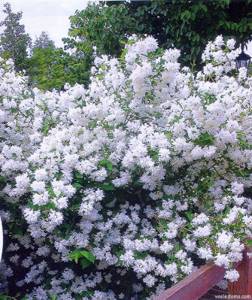
The right place, care and result - lush flowering
It is best to plant mock orange in the fall, from the second ten days of September to the first of October. If you did not have time to plant mock orange in the fall and do not want to lose the season, then you can plant it in the spring, but before the buds open. If the leaves have blossomed, the plant is likely to die. Be careful when planting, only the root should get into the soil, dig the stem and rotting may begin. The preferred planting depth is about half a meter. The interval between plants is from half a meter to one and a half.
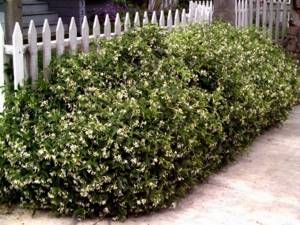
Mock orange in the form of a hedge is very attractive
If mock orange is planted as a future green fence, then maintain an interval of 50-80 centimeters between seedlings. After planting, you should water it with one, or better yet, two buckets of water, this is mandatory.
Reproduction
Mock orange is propagated by dividing roots or shoots with green young bark. They should be planted in previously prepared places, as they take longer to take root.
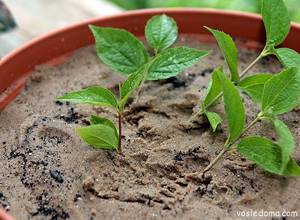
Future cuttings will take root and bloom much earlier than those sprouted from seeds
Mock orange can also be propagated by seeds. With this method, flowering of the bush can begin only after 5-8 years, and this is in good conditions, in a sunny place. Seeds can be planted in spring, autumn, and even winter in previously prepared grooves in the snow. Winter planting is usually covered with fallen pine needles or straw, or dry twigs, and removed in the spring. When the first shoots appear, they are limited in direct sunlight, but not completely deprived of sunlight. In the fall, mock orange seeds are sown in a ridge prepared in advance. Garlic is planted in the fall in a similar way. In the spring, seeds are usually sown in greenhouses, having previously been saturated with moisture (dipped into water in a nylon stocking, this starts the germination mechanism. Later they are transferred to peat, sawdust or another mixture that can retain moisture well. The swollen seeds are dried and sown with the addition of sand and manure.
Care
Caring for mock orange is simple and consists of the following: selecting a sunny place, fertilizing the soil, providing moisture and timely removal of dead, old, inward-growing and broken branches.
After planting, we remove weak branches and shorten the main ones. Such procedures help increase the number of buds, which will allow the plant to form a lush, symmetrical crown. If you did everything as expected, the shrub will begin to bloom in the first year after planting. In the third year of flowering of the bush, when the young shoots have gained strength and need new space for growth and future flowers, we remove the old branches, cutting them to the ground.
Watering and fertilizing
The next year after planting, we add mineral fertilizers to the soil for good growth and abundant flowering of mock orange. Composition per 10 liters of water: superphosphate 30g, potassium sulphide 15g, urea 15g. Prepared ten liters of fertilizer is enough for one or two small bushes. Slurry is very useful for the bush (1 liter of slurry per 10 liters of water), it is added annually to each bush. If you want the mock orange to bloom profusely and for a long time, during flowering, water each bush with 20-30 liters of water. After the end of flowering and before wintering, it is advisable to feed the bush with ash, which remains from burnt firewood.
Types of mock orange
Schrenk's mock orange
In our strip, this species is the first to bloom. His homeland is China, Korea, and the Far East. It has egg-shaped oval leaves, narrowed towards the top. Large flowers are collected in inflorescences of nine flowers, smell very delicate, their diameter is about 4 centimeters. Schrenk's mock orange plant is very frost-resistant, tolerates frosts down to minus 25°C. Blooms in early summer, flowering duration is about 25 days.

Schrenck mock orange flowers
Mock orange crown
This species grows up to three meters in height and has a wonderful aroma. Brought to our region from Western Europe. The white flowers smell simply divine, the leaves are large. Flowering begins in early June and lasts for about twenty days. It grows quickly, has beautiful foliage and many garden forms, and has a lifespan of up to 30 years.
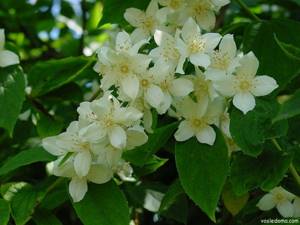
Mock orange crown
Small-leaved mock orange
The species is a low-growing bush with flowers that are very similar to cherry blossoms. During flowering, the entire bush is covered with flowers emitting the scent of strawberries.

Mock orange odorless
It has a tall bush, up to four meters in height and three meters in diameter, with large green shoots, large leaves reaching seven centimeters in length. On shoots that have not bloomed this season, the leaves can reach twelve centimeters. Large, about five centimeters, white flowers are shaped like a square, have no scent, and are collected in inflorescences of five flowers. An odorless mock orange, it blooms in the third decade of June and blooms for about a month.
Gordon's mock orange
The view is one of the largest. The norm is a bush 4 meters high. In the shade, trying to get closer to the sun, it can reach up to 6 meters. The leaves are large, bright green, glossy, which is very much appreciated by gardeners. The flowers are white, 4-5 centimeters in diameter, with a barely noticeable faint aroma. Flowering begins in June.
Fluffy mock orange
Has a three-meter bush. The lower leaves seem to be fluffy (airy). Blooms from the second half of July until August. The flower has almost no smell, compensating for the smell with the beautiful shape of the flower in the form of a cup. “calyxes” are collected in inflorescences of 5-10 pieces.
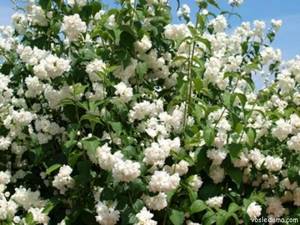
Fluffy mock orange flowers are collected in inflorescences of 5-10 pieces
Species of mock orange are selectively bred. Among the most famous: Moth Ballet, Arctic, Airborne Assault, Unusual, Pearl, Academician Komarov, Zoya Kosmodemyanskaya. My favorite was Airborne, a small two-meter bush with bell-like flowers with a delicate aroma. In addition, it is very good as a hedge.
Number two in my garden is the Unusual variety. The bush is not tall, only one and a half meters. A very beautiful flower with a purple spot inside.
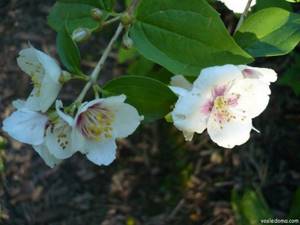
Flowers of the mock orange variety “Unusual”
But it is impossible to convey in words what kind of divine smell of strawberries its flowers exude.
Other Related Posts:
Features of reproduction
It is easy to propagate the plant. The process is carried out in several ways - layering, cuttings, root suckers, dividing the bush. If desired, you can also use seeds. To do this, they are buried 30 cm and then covered with straw or leaves. In spring the cover is removed.
During the process of propagation by cuttings, the blanks are kept in the basement in damp sand at zero temperature. In the spring, cuttings are planted in the holes, slightly tilting them. The root system of the plants will be formed by autumn; a year later by autumn it will be possible to transplant the plant to a permanent place.
When propagated by green cuttings, they are prepared in May. Seedlings are rooted in greenhouses or greenhouses. When the cuttings take root - after 2 months, they should be hardened off; after 2 years, the seedlings are planted in a permanent place.
When propagated by layering, young shoots are obtained from bushes, which are pressed and fixed in the ground. After it starts to grow upward, it is hilled up and watered. After 2 years, the finished bush can be planted in a permanent place.
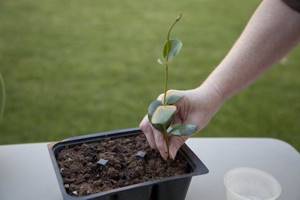
Variety of species and varieties
There are many types and varieties of mock orange. Let's look at the description of some of them.
| Type of mock orange | general description | Care requirements | Application in landscape design |
| Caucasian (Ph. caucasicus Koehne) | Three-meter bush with brown or yellow shoots, elliptical leaves, cream flowers | The soil should be moist and humus | Used in all types of plantings |
| Crown, Rosacea (Philadelphus coronarius) | The tree grows up to 3 m in height, the foliage is dense, the flowers are cream | Able to withstand frosts down to -25 degrees | Great for garden design |
| Small-leaved (Ph. microphyllus Gray) | Bush species - up to one and a half meters in height, elliptical leaves, white flowers, strawberry scent | Winter hardiness is average | Varieties are actively used in gardens |
| Large-flowered (Ph. grandiflorus Mild) | The bush reaches a height of 3 m, the flowers are white, large | The species is thermophilic, blooms poorly in the shade | Looks good in single plantings and hedges |
| Odorless (Ph. Inodorus) | Bush height - up to 3 m, chestnut-colored bark, cracking, white flowers | The species is not afraid of frost | Actively used in the garden |
| Fluffy (Ph. pubescens Loisel) | The leaves of the bush are pubescent below, the flowers are fragrant, plant height is 2 m, blooms annually | Winter-hardy, but new growth may freeze | Suitable for various plantings |
| Common (Philadelphus pallidus) | The bush can reach 3 m in height, leaves up to 8 cm, cream flowers | The plant has excellent winter hardiness | Varieties of this species are more popular than others, as they have many forms. Actively used in landscape design |
| Grayish (Ph. incanus Koehne) | Bush height – up to 5 m, simple, white flowers | Winter-hardy, blooms well under any conditions | Often used abroad |
| Broadleaf (Latifolius) | The flowers are cream, blooms for 25 days, the inflorescence is loose | It can freeze in Russia | The species is actively cultivated in America |
| Shrenka (Ph. schrenkii Rupr. et Maxim) | Deciduous bush, height – up to 3 m, peeling bark, egg-shaped leaves | Frost-resistant shrub | In parks, squares and gardens, in groups |
| Thin-leaved (Ph. tenuifolius Rupr. et Maxim.) | Height – up to 2.5 m, large leaves, thin in the light, white flowers | Shade-tolerant shrub, tolerates replanting well, resistant to smoke | Used in landscape design, excellent honey plant |
| Gordon (Ph. Gordonianus) | Bush - up to 4 m, flowering for 20 days, fragrant, white flowers | Not resistant to frost, not suitable for growing in central Russia | Not used for landscaping |
| Lemoine (Philadelphus x lemoinei) | Hybrid species, bush height – up to 3 m, lanceolate leaves, white flowers | The bush is unpretentious | Many varieties are used in the garden as decoration. |
Each type of mock orange has many varieties. What is their difference, we will consider further.
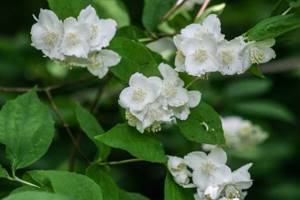
| Mock orange variety | general description | Care requirements | Application in landscape design |
| Pyramidalis | Tall bush, fan-shaped crown, many flowers | No special requirements | Excellent flowering, suitable for any conditions |
| Blizzard (Snezhnaja Burja) | Height – 1.5 m, curved branches, curved flower petals | Blooms early, does not have any special requirements | For planting alone and in groups |
| Komsomolets (Komsomol) | Low growing bush, green leaves, white flowers | A fairly winter-hardy variety, it does not make high demands | The flowers do not fall off for a long time, even after flowering, so the variety is not very decorative |
| Airborne (Aeris appulsum) | Bush height – up to 2.5 m, flowering for 3 years, cream flowers | Weather-resistant plant | An excellent option for creating a hedge |
| Ermine mantle (Murium pallium) | The height of the bush reaches 80 cm, the leaves are thin, the flowers are semi-double, the petals resemble a mantle. | Low maintenance | Superior in beauty to other varieties of mock orange |
| Strawberry (Avalanche) | Bush up to 1.5 m high, brown shoots, abundant flowering | Dies at a temperature of -15 degrees | Actively used in landscape design |
| Mazhory | Abundant flowering with white flowers, oval leaves, flower diameter up to 4 cm, spreading crown of the bush | Prefers sun, moderately moist soils | Single and group plantings, hedges |
The choice of mock orange variety in Siberia and other regions of Russia is carried out taking into account personal preferences and soil conditions. Climate features also play a role.
Chubushnik: a variety for the garden
If you are not a fan of gardening, you should choose mock orange, planting and caring for which does not take much time. Suitable varieties are Ordinary and Small-leaved , which can withstand frosts down to -25°C. For those who don’t mind tinkering with mulching and winter shelter, any shape is suitable.
Some types and varieties of mock orange that have proven themselves in landscape design in the Moscow region:
- Common : varieties Virginal, Flora-plena, Bicolore, Grandiflora, Aurea, Sybille, Salicifolia, Pumila, Belle Etoile, Duplex, Beauclerk.
- Crown : varieties Snowbelle, Aureus, Innocence, Nanus, Variegata,
- Lemoine : varieties Avalanche, Schneesturm, Pyramidal, Erectus, Alabasrite, Gletcher, Snow Avalanche, Flight of Moths, Blizzard, Elbrus, Airborne Assault, Arctic; dwarf Dame Blanche, Manteau d'Hermine, Moonlight, Dwarf, Dwarf.
- Virginia.
- Schrenk.
- small-leaved.
- Thin-leaved.
- Odorless.
- Gordon.
- Fluffy.

Combination of mock orange and other plants
Mock orange looks great in landscape design and in single plantings, as it blooms very beautifully. The bush looks like a large white bouquet. But a bush with double flowers can also be placed with a swing or a hammock, with a bench or a decorative mill.
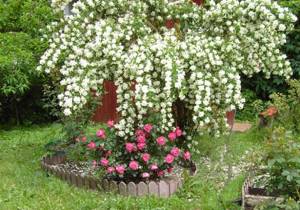
A plant such as garden jasmine feels great with the following neighbors:
- derain;
- weigela;
- lilac;
- barberry;
- spirea;
- peony;
- bloodroot.
So, mock orange is a highly decorative bush, actively used in landscape design. The wood of the plant is used to make flutes and pipes, as well as other crafts. In the garden, the bush is used as an ornamental plant, pleasing not only the eye, but also the sense of smell with its amazing aroma.
In one place, mock orange grows well for several decades. It does not require much attention, and blooms even in the shade, and also withstands severe frosts.
Using garden jasmine in landscape design
In landscape design, this shrub is usually used as a tapeworm, sometimes it is planted in small groups. In group plantings, plants with different heights and crown shapes, with different foliage colors are planted side by side.
In the garden they go well with lilacs, weigels, deutsias, spireas, and rhododendrons.
In the front garden, against the background of a brick wall, a spreading jasmine bush, along with peonies and phlox, also looks good.
Another use option is to create flowering alleys and hedges. From a huge variety of forms, you can always choose suitable varieties depending on your goals: there are varieties with dense tall bushes and compact ones for creating low hedges and borders. Even dwarf jasmines can be bought in nurseries - their height does not exceed 60 cm, they are suitable for edging flower beds.
The style of mock orange is ideal for a garden in the style of an old manor.
Lilac, jasmine and honeysuckle honeysuckle are so often mentioned in novels of the last century that they have become an indispensable attribute of the garden in the style of a noble estate of past centuries.




